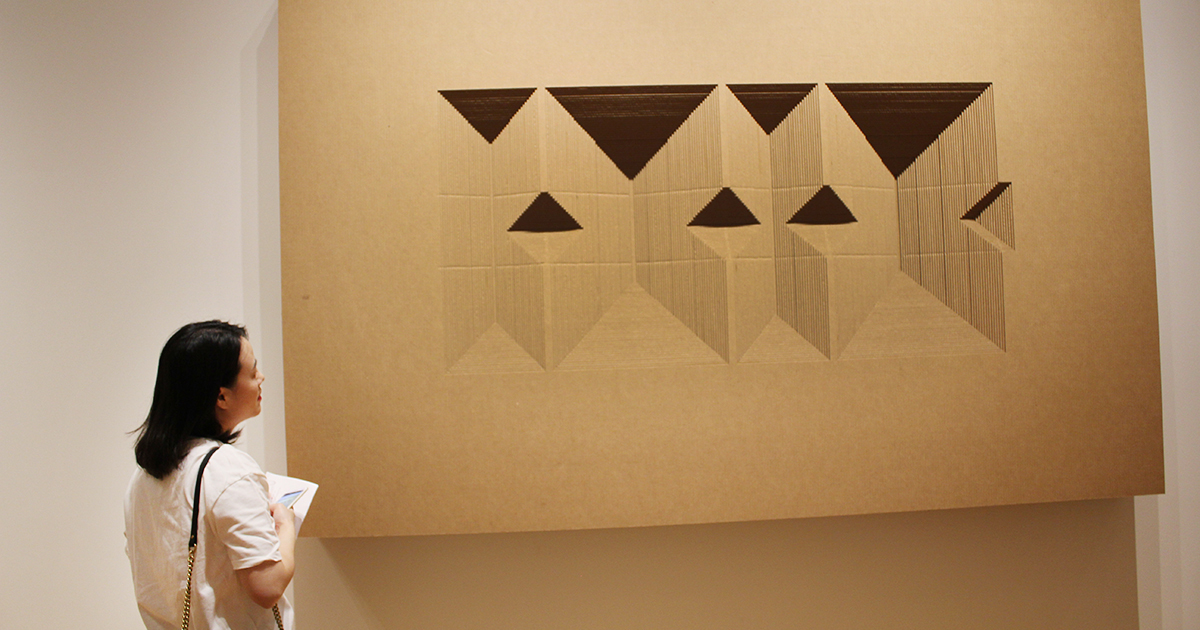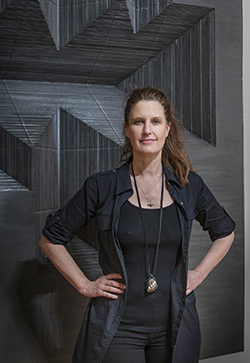Industrial artist’s ‘Drop Unit’ asks: What shapes us?

LAWRENCE – They’re not the biggest works of art University of Kansas Associate Professor of Design May Tveit has ever made. That would be the public artwork made of fabric curtains with which she covered the front of a six-story building some years ago.
 But the two large-scale sculptures, each nearly 9 feet in height or width, respectively, and on display through March 23 at the Greenlease Gallery at Rockhurst University in Kansas City, Missouri, are the largest things she has made since she embedded herself three years ago as an industrial artist at Lawrence Paper Company.
But the two large-scale sculptures, each nearly 9 feet in height or width, respectively, and on display through March 23 at the Greenlease Gallery at Rockhurst University in Kansas City, Missouri, are the largest things she has made since she embedded herself three years ago as an industrial artist at Lawrence Paper Company.
The pieces use the full-dimensional capabilities of the computer-driven machinery she uses to help create her art. She calls the show “Drop Unit,” a reference to industry jargon for excess material left behind when creating the desired form from raw material. The two monumental, corrugated cardboard sculptures and five small prints are created by using cardboard cut-out shapes to apply black translucent ink to white paper in impressions or imprints that echo the layers and spatial experience of the large works.
There is a sign outside the gallery warning visitors that the works contain powerful magnets that might interfere with their pacemakers.
Tveit said the large sculptures contain a hidden steel subframe that allows them to be mounted to the gallery wall. The two outermost layers are held to the ones below it with the magnets, she said.
Tveit said one of the works, titled “Drop Unit 1, more people love you than you know,” is made up of 108 layers of cardboard, while “Drop Unit 4, you have all the answers inside you, just get still” contains 47 layers.
Tveit said the pieces at Rockhurst are composed and constructed as a so-called “drop material” – and directly relate to a series of sculptures she created in 2017 for her solo exhibition titled “Universal Boxes” at the Nerman Museum of Art at Johnson County Community College in Overland Park. In that way, they are a reverse or negative image of the forms she showed then. If the pieces in the Nerman show rose off their mounting surface like pyramids, these feature voids.
“I was interested in creating volumes with the idea of the drop material,” Tveit said. “It wasn't necessarily about just going bigger. It was related to thinking about questions of what shapes us; what forms us; what influences us? What do we carry with us, and what do we let go of? If all of the objects at the Nerman were self-portraits in a way, these works consider what are the influences that shape us as individuals — whether they're people or places or circumstances. And those kind of invisible, intangible moments of memory take up space and can have physical weight and a persistent presence in our lives.”
As for the monoprints (meaning one-of-a-kind), Tveit said she made those on a much smaller scale, but using “a similar construction method of repetition and layering.”
In addition to providing her with raw material and state-of-the-art cutting tools, Lawrence Paper Co. — a 135-year-old, family-owned enterprise — gives Tveit access to the services of its package-design staff. They turn her sketches and measurements into computer-aided-design programs that cut the material to her specifications on their industrial-scale machinery.
Tveit said she has been bringing industrial design students to tour the factory for nearly the entire 20 years she has taught at KU, but she only embedded herself into the factory a couple of years ago.
And Tveit has lots more ideas to work on, she said.
“I am endlessly inspired by this place,” she said.
Top photo: A visitor at the Feb. 8 opening of May Tveit's "Drop Unit" art exhibit at the Greenlease Gallery at Rockhurst University. Credit: Rick Hellman, KU News Service
Inset photo: May Tveit in the gallery. Credit: E.G. Schempf.